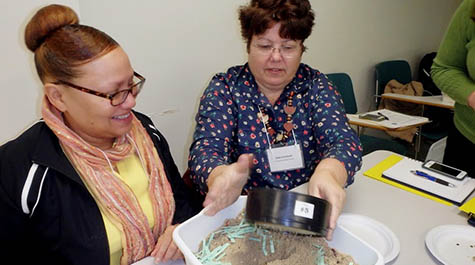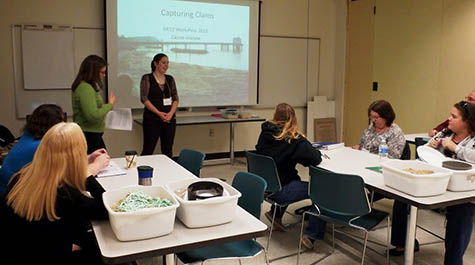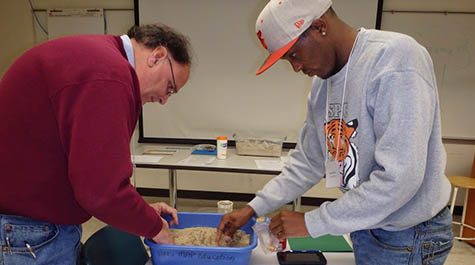VIMS hosts workshop for Virginia STEM educators
Teachers develop lesson plans derived from graduate-student research
In January, 51 middle and high school teachers from across the Commonwealth traveled to the Virginia Institute of Marine Science to learn engaging and authentic examples of scientific research in order to enhance their classroom lesson plans.
Lisa Ayers Lawrence and Carol Hopper Brill, VIMS extension staff affiliated with Virginia Sea Grant, created the workshop using resources developed during the VIMS GK-12/PERFECT project. The five-year program introduced graduate students to middle and high school classrooms as “visiting scientists” by highlighting their cutting-edge research and its real-world applications.
Sherrye Pollard, a science teacher at W.E. Waters Middle School in Portsmouth, attended the workshop and says it’s important for teachers to have a feel for what scientists do and how they collect data in order to properly communicate science to their students.
“The teachers who were able to participate in the GK-12 program were very fortunate to have that opportunity to interact and learn from the graduate students,” says Pollard. “Workshops like these are so important for teachers to learn about other activities and opportunities for their classroom, and allow for their growth as educators.”
“Teachers are looking for engaging and authentic examples of scientific research to use with their students,” says Lawrence. “While VIMS educators have a long history of translating current science into classroom-friendly resources, when graduate students are the presenters, it conveys the groundbreaking research being done by young scientists.”
January’s workshop aimed to introduce the GK-12/PERFECT collection of more than 70 activities by engaging teachers in selected examples. Seven former fellows joined the workshop by each offering educational sessions and the teachers had the opportunity to pick the four sessions that would enhance their lessons plans the most.
“There was a nice diversity of grade levels and subjects represented by the teachers,” says Lawrence. “Because of this, their sessions were pretty evenly spread out which meant that most everyone got to see their top-ranked sessions.”
“I would highly recommend this workshop to all science teachers,” says Pollard. “I have already spoken with teachers about what a wonderful experience it was and how they should attend this type of offering if it becomes available in the future.”
Lawrence says during the GK-12/PERFECT project, VIMS held an annual lesson expo for the fellows to conduct demonstrations for the 12 partner teachers. “The teachers always said we should do a similar presentation for teachers outside the project,” she says. “As part of an extension of the project, we worked to make these resources available to more teachers across the state of Virginia.”
In addition to the information gained during the individual sessions, each workshop participant received a $200 stipend, a flash drive with the GK-12/PERFECT lesson collection, and classroom materials to enhance their lesson plans.
Over the course of 5 years, the GK12/PERFECT program reached approximately 5,500 students. Forty-one fellows participated for one year, while six participated for two years with a grand total of more than 13,100 hours spent in the classroom.
While a majority of the teachers who attended the workshop were new to the program, four of the GK-12 partner teachers attended to help facilitate discussion. Funding for the workshop was provided by the National Science Foundation grant for the VIMS GK-12/PERFECT project.
Lawrence says the GK-12/PERFECT project has been a win-win for graduate students and educators in our area. “Everyone involved has benefitted greatly from the project,” she says. “We are actively looking for funding sources that will provide long-term support for similar efforts.”
Sessions
Bioturbation in the Baltic Benthos: VIMS alumnus Matt Freedman
A simulation in which students model the burrowing and feeding behavior of an invasive worm in the Baltic Sea. The introduction of the worm in 1985 caused an unwelcome problem: Toxic pollutants that had been banned and were safely sequestered in the seafloor sediment were dredged back up by the worms. After witnessing this phenomenon in their models, students are challenged to turn the simulation into a quantitative experiment. Finally, students engage in a role-playing scenario in which they propose strategies to control the worm invasion.
Capturing Clams: VIMS graduate student Cassandra Glaspie
Students design experiments and sampling schemes for assessing clam abundance in two different mock habitats: seagrass meadow and the sandy seafloor (shoeboxes of sand, artificial grass, and buried beans as clams). Students then analyze and interpret the data.
The Daily Catch: VIMS graduate student Annie Murphy
A hands-on simulation in which students adopt various stakeholder roles (scientists, policymakers, and commercial and recreational fishers), make season-by-season decisions for a fishery, and model the long-term consequences of those decisions on the fish stock. Involves critical thinking and simple math, and illustrates the complex, dynamic nature of fished populations and the challenges of sustainably managing them.
A Day as a BATS Scientist: VIMS graduate student Jami Ivory
Lesson introduces long-term oceanographic research on zooplankton populations. Students analyze scans of magnified zooplankton samples, identify major taxa, count the number from each group, and graph a time series. They then compare their trends to graphs of other environmental data collected on the same dates and at the same sites, and propose explanations for the population trends.
Groundwater, Land Use & Eutrophication: VIMS graduate student Britt Dean
Working in teams, students create a model of one of three land-use scenarios (urban, agricultural, or wetland) to investigate how land use affects eutrophication. By tracing the movement of “pollutants” through their models, students evaluate the connection between land-use and pollution entering the groundwater.
Mysteries in the Mud: VIMS alumna Christina Pondell
A hands-on simulation in which student teams compete to win a contract as geological researchers for a major corporation. They draw cores from sedimentary deposits (basins of sand) and determine the relative ratio of different biomarkers (marbles), “chemical fossils” that leached from living organisms and now serve as clues to what type of ancient environment left the deposit. Integrates simple math and mimics real geological “detective work.”
Sea-Level Rise in Coastal Virginia: VIMS Postdoctoral Researcher Sam Lake
Through demonstrations, video clips, and a hands-on investigation, this lesson explores global, regional, and local processes driving sea level rise in coastal Virginia. Students cut out maps to calculate the surface area of Virginia Beach that would be inundated under three sea-level-rise scenarios. They then propose mitigation strategies, present them to the class, and learn what local and international groups are doing.




